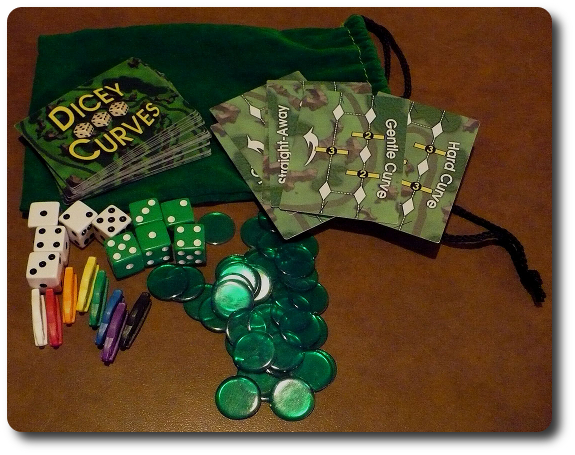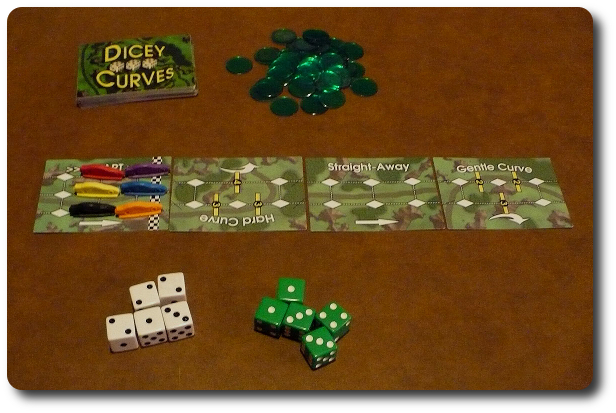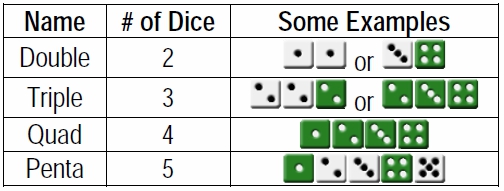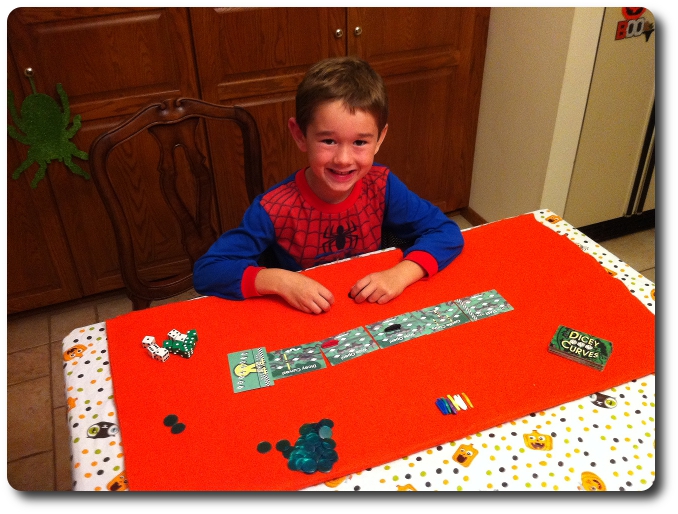
The Basics:
- For ages 4 and up (designer suggests 12+)
- For 2 to 8 players
- About 30 minutes to play
Geek Skills:
- Counting & Math
- Logical & Critical Decision Making
- Strategy & Tactics
- Hand/Resource Management
Learning Curve:
- Child – Easy
- Adult – Easy
Theme & Narrative
- Jump behind the wheel of your race car and out maneuver and out fox your opponents by balancing strategy, tactics, and luck to win the race!
Endorsements:
- Gamer Geek approved!
- Parent Geek approved!
- Child Geek approved!
Overview
In Dicey Curves, players jump behind the wheel and race each other, jockeying for position and control. While speed is important, a skilled driver knows that positioning is just as important, if not more so. This is a light strategy race game where luck and tactics go hand in hand. Expect quick play and surprisingly engaging game mechanics that will have you looking for the best path and approach to victory!
Dicey Curves is comprised of 8 race car pawns, 5 white six-sided dice, 5 green six-sided dice, 40 Control Chips, and 36 Track cards. Lots of choking hazards in this game, so if you have little geeks still putting things in their mouths, put this on a high shelf when not in use. There isn’t anything else to this game in regards to bits and pieces, but what is there is used and used a great deal. This game is currently only available from The Game Crafter store.

Not a lot of “flash” component wise, but a whole lot of fun!
Jumping Behind the Wheel
Dicey Curves can handle 2 to 8 players. The players control one car each or, if there are less than 8 players, the cars can be split equally among them allowing each player to control more than one car. For example, a 2-player game would allow each player 4 cars, a 3-player game would allow each player 2 cars, and so on. Note that this is optional and for younger players and inexperienced players, it is recommended that each player only have 1 car to control.
Track Set Up
There are two ways to set up Dicey Curves. The first is referred to as a “Mystery Rally”, which creates a randomly generated race track each and every time. The second is referred to as a “Set Course”, which allows the players to create their own race track.
To set up a “Mystery Rally”, remove the Start and Finish cards from the Track deck. Shuffle the deck and slide the Finish card back into the deck near the middle. Note that the placement of the Finish card determines the length of the track and therefore the length of the game. For shorter races, place the Finish card closer to the top of the deck. For longer tracks and longer games, place the Finish card towards the bottom of the deck. Once the Finish card is back in the deck, place the Start card on the table and draw three cards from the Track deck, placing them next to the Start card.
As the race progresses, add new Track cards whenever there are fewer than 2 empty tracks in front of the lead player. In this way, the race track continues to open and all the players are kept in the dark about how close (or far) they are away from the finish line!
To set up a “Set Course”, use as many cards as you like and create the track in any design as needed using the Start and Finish cards. Any cards left in the Track deck are removed for the duration of the game.
Car Placement
Once the track has been built, the players determine who will go first using whatever method is agreed upon. The first player places their car on one of the eight spots on the Start card, followed by the second player and so on until all the players have placed their first car. Placement is meaningful as it determines how much further ahead one car is to another. If players are controlling more than one car, the last player who placed a car now places their second car and the order of car placement is reversed. This back and forth continues until all the cars are placed.
Very last, each player is given 2 Control Chips to start with. The dice and the remainder of the Control Chips are placed to one side of the game until needed.
Pressing the Gas
On a player’s turn, they will roll dice, move their car, and possibly gain Control Chips. The first step is to roll the dice. Each player starts by rolling the 5 white six-sided dice. For every “6” rolled, the dice can be re-rolled and an unused green six-sided die added, if available. In the game, this is referred to as “exploding dice”. The player continues to roll the dice, adding green dice if necessary, until all the dice rolled have a value of 5 or less.
The goal is to roll as many combos as possible using both the white and green dice, where a combo is two or more dice that are all the same value or consecutive values. See the following image for just some of the possible combos.

The number of combos a player creates determines two things in the game. First, the number of spaces they can move their car during their turn and second, possible Control Chips at the end of their turn. The player is never required to play all their combos and the player can create as many or as few combos as the dice allow, tailoring their car’s speed and distance traveled. Each dice grouping can only be counted once, so the player will need to strategize how best to use their dice for maximum efficiency. The player also has the option of not moving their car at all on their turn.
Cars move along the race track, always forward or sideways, on dotted path lines and each movement is counted by white diamond spots. The number of spots the car can move is equal to the number of dice in their combos. For example, a triple would allow the car to move 3 spots.
Cars jump from their starting spot to an open spot ahead or adjacent to them. Cars can never stop on the same space as another car and must always stop on the spot right before a control a gate. These gates have a number on them and the player must have a combo of the same size in order to pass. For example, a gate with a “4” on it means the player must use a quad-combo to pass it. Combos that are used to pass gates cannot be used to move spots.

The Track cards show a great deal of information without being confusing
When the player plays their last combo, a single die (which will move the car only one spot), or they cannot move because of their position, their turn is over. Any combos not used can be turned into Control Chips at the end of the player’s turn. Doubles provide the player with 1 Control Chip, Triples provide 2, and Quads or better provide 3 chips.
Control Chips
Control Chips can be a player’s best friend if played correctly. Control Chips allow the player to take special actions during their turn for the cost of one Control Chip each.
Playing Control Chips while rolling dice to:
- Add One Green Die: grab any unused green dice and assign it any value from 1 to 5
- Re-Roll Any Number of Dice: re-roll any dice already in play
Playing Control Chips when you are moving your car to:
- Continue Playing Dice: when a player plays a single dice, their turn is over; however, at the cost of one Control Chip, the player can continue to play dice
- Juke: the player can exchange his car’s position with another car that is side-by-side and connected with path lines
- Control Another Player’s Car: play the rolled dice using your opponent’s car – that player still gets their turn
A player may never hold anymore than 5 Control Chips.
The Turbo Pass
The rules state that a player must stop on the spot before a gate. If another car is occupying that space right before the gate at the start of the player’s turn, they may attempt a Turbo Pass. This is the only way a player can get around cars that are between them and the next gate with no open spots. To Turbo Pass, the player must roll a combo equal to the number of spots to the next available open spot. In addition, they must also roll a combo to satisfy the gate requirements. Expect heavy use of Control Chips when attempting a Turbo Pass as these combos are difficult.
Winning the Race
There is a numbered position spot for each car as they pass the finish line. If each player is controlling a single car, the player who crossed the finish line first is declared the winner. If players are controlling multiple cars, their lowest placement position is multiplied by 2 and then added to their highest position placement. For example, if the player was in the 1st and 5th position, their score would be 11 (1 + (5×2) = 11). The player with the lowest score wins. In case of a tie, use the highest position placement to determine the winner.
This concludes the summary of the rules. For the complete rules and additional examples of play, see the Dicey Curves official web site.
Prediction
My little geeks love race car games. To date, their favorites are Monza followed by Scooby-Doo! Coolsville 500. Both of these games play very differently. Monza focuses on pattern matching while Scobby-Doo! Coolsville 500 is all about card hand management. Dicey Curves appears to be a mix of the two using dice and luck; however, the grouping of dice and the Control Chips provide the players choice, strategy and tactics. This is an excellent “next step game” for my little geeks for two reasons. First, it builds off the geeks skills and game mechanics they have already learned in other games. This will make it easier for them to learn the game and start playing. Second, Dicey Curves requires the player to “think ahead” and determine how best they are going to manage a race course that has not yet been fully revealed. Reaction is replaced by action, allowing my little geeks to strategize and determine what tactics would be best. Full speed or a subtle positioning for the next round? All of this is done through the use of their rolled combos that they group together.
My biggest concern is the ability for another player to control another car. While any damage done to that player is slight at best (as the car must always move forward or to the side), my little geeks have not yet come to a “happy place” when they lose control of their game piece. This is especially apparent when we play Heroscape or LEGO Heroica and their game pieces get taken off the board. I might have to do some damage control if things get out of hand and feelings are hurt.
The only rule I had to explain several times to my little geeks was the Turbo Pass which can be fairly confusing until you see it demonstrated in the game. After a few quick examples of dice groupings and car movement, both of my little geeks were ready to play. While I shuffled the Track deck, I asked my son’s their thoughts as they got ready to race.
“I like how I can control my car through the dice and I get to decide how the dice are used.” ~ Liam (age 7)
“And I like how I can go really fast or really slow. But I’m going to go really fast all the time!” ~ Nyhus (age 4)
Checking to ensure that both my sons were strapped in tight in their booster seats, helmets secure, and goggles on, we started our engines and raced!
Final Word
Here is what makes a great game for me. It isn’t the quality of the components. It isn’t the theme. It isn’t even how long or short the game is played. What makes a game great is how it makes the players interact and think. It is how the game engages them, and in turn, how the players engage each other. Dicey Curves takes a very simple theme and game mechanic and makes it a lively and entertaining experience for all the players as they see the race track appear before them and watch as the cars slip behind and in front of each other again and again. To say my races were nail biting would be an understatement. I was compelled many times to shout “YEEEHHHAA!” when I was able to group the dice the way I wanted and groan loudly when I was out positioned by my little geeks. Many times, the entire table threw their hands up in disgust and worry as a new Track card was revealed only to show a very difficult piece of the course ahead that would cause all of us to lose our momentum and carefully drive through tight corners and choke points on the track. Dicey Curves created a wonderful shared experience in which we were all invested.
My concern over players being able to move another player’s car were put to rest quickly in the game. My 7-year old spent a Control Chip to move me to the side and then up to stop at a difficult gate allowing him to move through a much easier gate without hassle. When I did the same to him, he just smiled and said, “fair is fair, Dad.” I was so proud! Amazing how fast little geeks grow in both size and maturity.
My little geeks loved the game. It is fast to set up, fast to play, and provides the little geeks a lot of room to use their minds. My 4-year old struggled at first, but was able to “connect the dots”, so to speak, and quickly found his footing and speed. At no time in the game did it ever feel that one player was a sure winner. Our races were always close which made it all the more entertaining. I understand why the game designer suggests 12 and over as there is a surprising depth to the strategy and tactics used in the game. An inexperience player will have a tougher race than a player who has already grasped the need for control versus flat-out speed. However, this simple truth is revealed again and again to the player and it will not be long before they adopt it and catch up to the pack.

The race game combines fast play and luck with a surprising depth of strategy and tactics
Gamer Geeks, you are going to enjoy this light and fast dice game. This is a perfect game filler or starter/ender game. There is excellent use of strategy and tactics that balances out the luck which puts a lot of control in the hands of the players. The game quickly becomes skill vs. skill when played with the game elitists and an incredibly good time. You’ll be surprised how much fun you have with such a simple game played in such a short time.
Parent Geeks are going to love this game because it is fast to set up and play. Easy rules with game mechanics that allow the inexperienced to compete with the experienced will ensure that everyone at the table is engaged and in the race. The number of players the game can comfortably sit is also a huge bonus. This makes Dicey Curves a true family or families game with up to 8 players. The non-gamers are going to enjoy the simple dice rolling mechanics and the parents are going to smile with pride as they see their little geeks counting and strategizing how best to move their car forward, maximizing the full potential of their turn.
Child Geeks, start your engines! This race game has been officially approved by a 4 and 7-year old. And I quote, “RADICALLY COOL!” I don’t know if you can get a better endorsement than that from little geeks. Math and counting are used, but the numbers they will add are small and the dice they group is very manageable. Expect to assist the younger little geeks with the combos at first, but they should be able to be driving on their own within a couple of turns. The game also allows the little geeks to flex their creative muscle if they want to build their own race track and challenge Mom and Dad to an epic race at the family table!
I couldn’t be more pleased with Dicey Curves and was very pleasantly surprised by this fast and fun race game. To be truthful, I didn’t expect much when I looked through the contents and briefly scanned the rules. Shame on me, as I have always told my little geeks to never judge a book by its cover. I must now amend that old adage by including “never judge a game by its components”. Light, fast, fun, challenging, endless replay value, and rewarding, Dicey Curves was a hit at my family table and I’m sure you’ll enjoy it, too.
To learn more about the game, visit the Dicey Curves official web site or the product ordering page on The Game Crafter.
This game was given to Father Geek as a review copy. Father Geek was not paid, bribed, wined, dined, or threatened in vain hopes of influencing this review. Such is the statuesque and legendary integrity of Father Geek.




Pingback: Father Geek Likes Dicey Curves (and so do his little geeks!) | Matt Worden Games
Pingback: Dicey Curves: DANGER! Game Expansion Review - Father Geek
Pingback: Dicey Curves: Road Rally Game Review - Father Geek